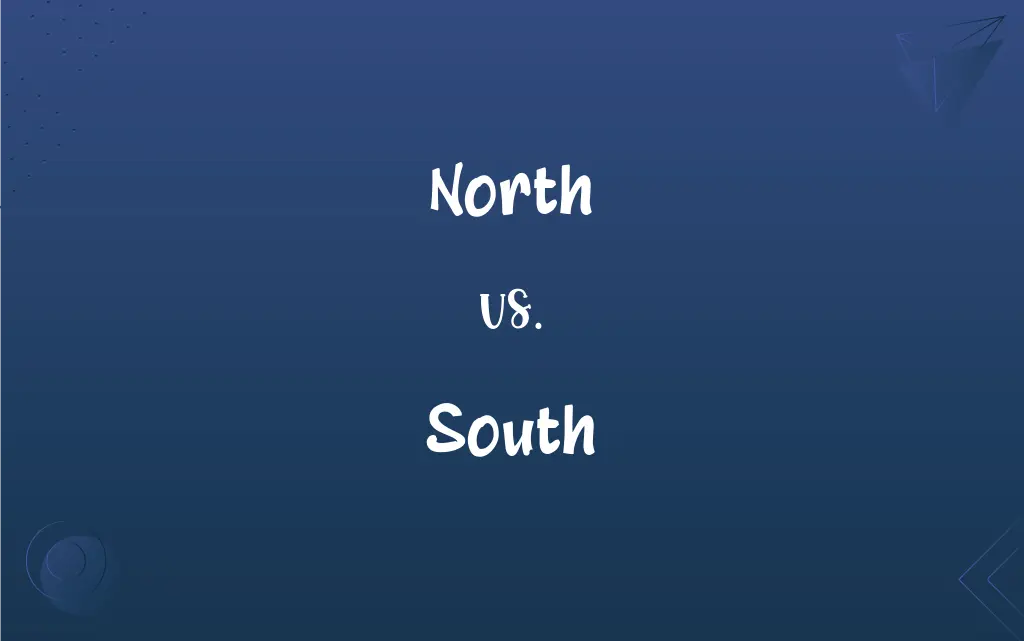North vs. South: What's the Difference?
Edited by Harlon Moss || By Janet White || Published on November 20, 2023
North: Direction opposite of south. South: Direction opposite of north.

Key Differences
North is a cardinal direction, traditionally associated with colder climates. South is also a cardinal direction, often linked with warmer regions.
In the Northern Hemisphere, the North Pole is the northernmost point. In contrast, the South Pole is the southernmost point in the Southern Hemisphere.
North is often used to denote the top of maps. South, conversely, usually represents the bottom of maps.
Culturally, North can symbolize progress or advancement. South can represent warmth, relaxation, or even decline.
In terms of navigation, North is a key reference point. South, equally important, serves as an opposite point for orientation.
ADVERTISEMENT
Comparison Chart
Climate
Generally colder
Generally warmer
Geographic Pole
North Pole
South Pole
Map Representation
Top
Bottom
Cultural Symbolism
Progress, advancement
Warmth, relaxation, decline
Navigation Role
Key reference point
Opposite point for orientation
ADVERTISEMENT
North and South Definitions
North
Cardinal direction opposite of south.
The compass pointed north.
South
Cardinal direction opposite of north.
The birds migrated south for the winter.
North
Direction towards the North Pole.
They traveled north for miles.
South
Direction towards the South Pole.
They set sail heading south.
North
The direction along a meridian 90° counterclockwise from east; the direction to the left of sunrise.
South
Can imply relaxation or leisure.
They headed south for a relaxing vacation.
North
The cardinal point on the mariner's compass located at 0°.
South
The direction along a meridian 90° clockwise from east; the direction to the right of sunrise.
North
An area or region lying in the north.
South
The cardinal point on the mariner's compass 180° clockwise from due north and directly opposite north.
North
The northern part of the earth.
South
An area or region lying in the south.
North
The northern part of a region or country.
South
The southern part of the earth.
North
North The northern part of the United States, especially the states that fought for the Union in the Civil War.
South
The set of developing nations of the world, largely located to the south of the developed nations of the Northern Hemisphere.
North
The side of a church which is to the left as one faces the altar. Also called liturgical north.
South
The southern part of a region or country.
North
To, toward, of, facing, or in the north.
South
South The southern part of the United States, especially the states that fought for the Confederacy in the Civil War.
North
Originating in or coming from the north
A cold north wind.
South
The side of a church which is to the right as one faces the altar. Also called liturgical south.
North
In, from, or toward the north.
South
To, toward, of, facing, or in the south.
North
(Slang) Into a better condition, as of increased value
An investment that went steadily north until the market crash.
South
Originating in or coming from the south
A hot south wind.
North
One of the four principal compass points, specifically 0° (being directed towards the North Pole); conventionally upwards on a map.
Minnesota is in the north of the USA.
South
In, from, or toward the south.
North
The up or positive direction.
Stock prices are heading back towards the north.
South
(Slang) Into a worse or inferior condition, as of decreased value
A stock that went south shortly after he bought it. "If a life could be redeemed in a moment, it could go south just as fast" (Roy Parvin).
North
(physics) The positive or north pole of a magnet, which seeks the magnetic pole near Earth's geographic North Pole (which, for its magnetic properties, is a south pole).
South
One of the four principal compass points, specifically 180° (being directed towards the South Pole); conventionally downwards on a map.
North
.
South
The southern region or area; the inhabitants thereof.
North
(ecclesiastical) In a church: the direction to the left-hand side of a person facing the altar.
South
(ecclesiastical) In a church: the direction to the right-hand side of a person facing the altar.
North
Of or pertaining to the north; northern.
He lived in north Germany.
She entered through the north gate.
South
(figurative) down or the negative direction
His fortunes have been going south ever since he was tricked into investing in that ostrich farm.
North
Toward the north; northward.
South
(physics) The negative or south pole of a magnet
North
(meteorology) Of wind, from the north.
The north wind was cold.
South
Toward the south; southward.
North
Pertaining to the part of a corridor used by northbound traffic.
North highway 1
South
From the south.
North
(ecclesiastical) Designating, or situated in, the liturgical north (in a church, the direction to the left-hand side of a person facing the altar).
South
Of or pertaining to the south; southern.
North
(colloquial) More or greater than.
The wedding ended up costing north of $50,000.
South
Pertaining to the part of a corridor used by southbound traffic.
South highway 1
North
Toward the north; northward; northerly.
Switzerland is north of Italy.
We headed north.
South
(ecclesiastical) Designating, or situated in, the liturgical south.
North
To turn or move toward the north.
South
Toward the south; southward.
North
That one of the four cardinal points of the compass, at any place, which lies in the direction of the true meridian, and to the left hand of a person facing the east; the direction opposite to the south.
South
Downward.
North
Any country or region situated farther to the north than another; the northern section of a country.
South
In an adverse direction or trend (go south).
North
Specifically: That part of the United States lying north of Mason and Dixon's line. See under Line.
South
(meteorology) Of wind, from the south.
North
Lying toward the north; situated at the north, or in a northern direction from the point of observation or reckoning; proceeding toward the north, or coming from the north.
South
To turn or move toward the south; to veer toward the south.
North
To turn or move toward the north; to veer from the east or west toward the north.
South
(astronomy) To come to the meridian; to cross the north and south line.
The moon souths at nine.
North
Northward.
South
That one of the four cardinal points directly opposite to the north; the region or direction to the right or direction to the right of a person who faces the east.
North
The region of the United States lying north of the Mason-Dixon Line
South
A country, region, or place situated farther to the south than another; the southern section of a country.
North
The United States (especially the northern states during the American Civil War);
He has visited every state in the Union
Lee hoped to detach Maryland from the Union
The North's superior resources turned the scale
South
Specifically: That part of the United States which is south of Mason and Dixon's line. See under Line.
North
The cardinal compass point that is at 0 or 360 degrees
South
The wind from the south.
North
Any region lying in or toward the north
South
Lying toward the south; situated at the south, or in a southern direction from the point of observation or reckoning; proceeding toward the south, or coming from the south; blowing from the south; southern; as, the south pole.
North
The direction in which a compass needle points
South
Toward the south; southward.
North
British statesman under George III whose policies led to rebellion in the American colonies (1732-1792)
South
From the south; as, the wind blows south.
North
Situated in or facing or moving toward or coming from the north;
Artists like north light
The north portico
South
To turn or move toward the south; to veer toward the south.
North
In a northern direction;
They earn more up north
Let's go north!
South
To come to the meridian; to cross the north and south line; - said chiefly of the moon; as, the moon souths at nine.
North
Upper part or top of a map.
Her hometown was marked at the north of the map.
South
The region of the United States lying south of the Mason-Dixon Line
North
Symbol of cold or frigid conditions.
The wind blew from the north, chilling the air.
South
The southern states that seceded from the United States in 1861
North
Often used to denote progress.
Their journey north signified new beginnings.
South
The cardinal compass point that is at 180 degrees
South
Any region lying in or toward the south
South
Situated in or facing or moving toward or coming from the south;
The south entrance
South
In a southern direction;
We moved south
South
Lower part or bottom of a map.
The river flowed to the south of the city.
South
Symbol of warmth or hot conditions.
The south wind brought a heatwave.
FAQs
What's generally true about the climate in the North?
It's traditionally colder.
Where can you find the South Pole?
At the southernmost point of the Earth.
What is North?
A cardinal direction opposite of south.
Is North important for navigation?
Yes, it's a key reference point.
Where is the North Pole located?
At the northernmost point of the Earth.
How is South shown on maps?
Often as the bottom or lower part.
What does South often symbolize?
Warmth, relaxation, or sometimes decline.
What role does South play in navigation?
It serves as an opposite point for orientation.
What does South represent?
A cardinal direction opposite of north.
Is the South usually warmer?
Yes, typically associated with warmer climates.
How is North depicted on maps?
Usually as the top or upper part.
What can North symbolize culturally?
Progress, advancement, or coldness.
In global politics, what does the North represent?
Sometimes industrialized or developed nations.
Can North imply a direction of travel?
Yes, moving towards the North Pole.
Does traveling South mean heading towards the South Pole?
Generally, yes.
Are North and South used in navigation globally?
Yes, they are fundamental directional references.
Does North have a symbolic meaning in literature?
Often represents harshness or challenges.
What symbolic meaning can South have in literature?
It can symbolize escape or comfort.
What does the South represent in global politics?
Often developing or tropical regions.
Can North and South indicate cultural divisions?
In some contexts, they signify cultural or economic differences.
About Author
Written by
Janet WhiteJanet White has been an esteemed writer and blogger for Difference Wiki. Holding a Master's degree in Science and Medical Journalism from the prestigious Boston University, she has consistently demonstrated her expertise and passion for her field. When she's not immersed in her work, Janet relishes her time exercising, delving into a good book, and cherishing moments with friends and family.
Edited by
Harlon MossHarlon is a seasoned quality moderator and accomplished content writer for Difference Wiki. An alumnus of the prestigious University of California, he earned his degree in Computer Science. Leveraging his academic background, Harlon brings a meticulous and informed perspective to his work, ensuring content accuracy and excellence.






































































